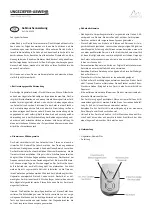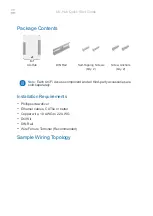
5-144
L60 LINE PHASE COMPARISON SYSTEM – INSTRUCTION MANUAL
SYSTEM SETUP
CHAPTER 5: SETTINGS
5
5.4.2 Power system
SETTINGS
SYSTEM SETUP
POWER SYSTEM
The power system
NOMINAL FREQUENCY
value is used as a default to set the digital sampling rate if the system frequency
cannot be measured from available signals. This can happen if the signals are not present or are heavily distorted. Before
reverting to the nominal frequency, the frequency tracking algorithm holds the last valid frequency measurement for a
safe period of time while waiting for the signals to reappear or for the distortions to decay.
The phase sequence of the power system is required to properly calculate sequence components and power parameters.
The
PHASE ROTATION
setting matches the power system phase sequence and informs the relay of the actual system phase
sequence, either ABC or ACB. CT and VT inputs on the relay, labelled as A, B, and C, must be connected to system phases A,
B, and C for correct operation.
The
FREQUENCY AND PHASE REFERENCE
setting determines which signal source is used (and hence which AC signal) for
phase angle reference. The AC signal used is prioritized based on the AC inputs configured for the signal source. Phase
voltages takes precedence, followed by auxiliary voltage, then phase currents, and finally ground current.
For three phase selection, phase A is used for angle referencing (V
ANGLE REF
= V
A
), while Clarke transformation of the phase
signals is used for frequency metering and tracking (V
FREQUENCY
= (2V
A
- V
B
- V
C
) / 3) for better performance during fault,
open pole, and VT and CT fail conditions.
The phase reference and frequency tracking AC signals are selected based upon the source configuration, regardless of
whether or not a particular signal is actually applied to the relay.
Phase angle of the reference signal always displays zero degrees and all other phase angles are relative to this signal. If the
pre-selected reference signal is not measurable at a given time, the phase angles are not referenced.
The phase angle referencing is done via a phase locked loop, which can synchronize independent UR-series relays if they
have the same AC signal reference. This results in very precise correlation of phase angle indications between different UR-
series relays.
FREQUENCY TRACKING
is set to “Disabled” only in unusual circumstances; consult GE Grid Solutions for special variable-
frequency applications.
The nominal
PHASE VT F5 SECONDARY
voltage setting is the voltage across the relay input terminals when nominal
voltage is applied to the VT primary.
For example, on a system with a 13.8 kV nominal primary voltage and with a 14400:120 volt VT in a delta
connection, the secondary voltage is 115; that is, (13800 / 14400) × 120. For a wye connection, the voltage value
entered must be the phase to neutral voltage, which is 115
/
= 66.4.
On a 14.4 kV system with a delta connection and a VT primary to secondary turns ratio of 14400:120, the voltage
value entered is 120; that is, 14400 / 120.
POWER SYSTEM
NOMINAL FREQUENCY:
60 Hz
Range: 25 to 60 Hz in steps of 1
PHASE ROTATION:
ABC
Range: ABC, ACB
FREQUENCY AND PHASE
REFERENCE: SRC 1
Range: SRC 1, SRC 2, SRC 3, SRC 4
FREQUENCYTRACKING:
Enabled
Range: Disabled, Enabled
The frequency tracking feature functions only when the L60 is in the “Programmed” mode. If the L60 is “Not
Programmed,” then metering values are available but can exhibit significant errors.
















































